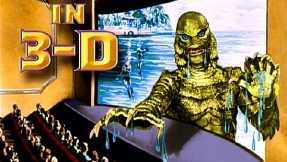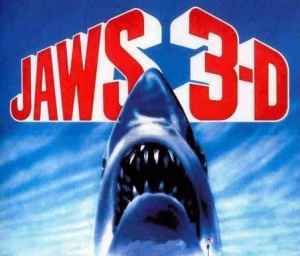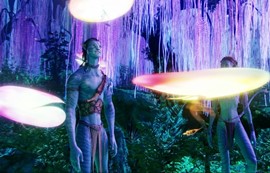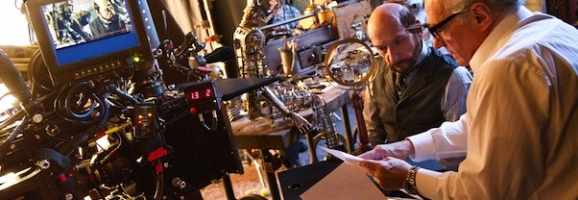The Relationship Between 3D Technology and a Film’s Success
3D technology has seen another surge in demand. But is the boom in 3D movies any different from the previous trends? During the 1950’s – also known as the golden era for 3D movies – the plastigram system was used. This involved a method called anaglyph, where two images are photographed and projected on the same strip of film through different color filters, one red and one green. When the eye looks through the corresponding colors in the viewer, the images separates, creating a 3 dimensional effect. This was a very difficult technique to use, however the technology was not available at the time for an improved system. The first surge in 3D productions was caused by the success of Arch Oboler’s Bwana Devil, the “Lion in your lap” 3D blockbuster. The major studios took note of its success and rushed their own 3D films into production, many of which were similar horror/monster movies.

Jack Arnold’s Creature from the Black Lagoon was released in 1954, which was the baby boom period after World War II. The increase in birth rate provided the film producers with a largely teenage market, easily enticed by the “It comes off the screen right at you!” advertisements. Teens with money burning holes in their pockets loved 3D B-movies like Creature from the Black Lagoon for the cheap thrills they provided. Like when actress Julie Adams is on the boat wearing an elegantly alluring, flowery swim suit when she is swept off her feet by the 3D Creature. It was a text-book example of a monster movie. But the 3D gimmick gave cinema audiences an ‘alien’ experience that genuinely caused fright and was responsible for a large majority of tickets sold due to its fresh spectacle, helping it become a monster movie to be remembered.

After the 1950’s 3D craze fizzled out – mainly due to the increased labor required for 3D at the time – it reawakened in the early 1980’s when the exploitation picture Jaws 3-D briefly piqued the curiosity of young audiences. Joe Alves shot the film using the arrivision 3D system. This involved using a special twin lens adapter fitted to the camera, which divided the 35 mm film frame in half along the middle. The upper half recorded footage for the left eye, and the bottom half for the right eye. This period of films had no real overwhelming success in the three-dimensional regions. It was an echo of the 1950’s period, using 3D as a gimmick to boost the number of ticket sales. Cinema-goers became more conscious that productions were capitalizing on a craze and the once revolutionary spectacle became annoying and lost its novelty. However in 1983 the only way to get audiences back in to cinemas to see another Jaws sequel was to shoot it in 3D. Not only was the film overly soft – showing poor focus – it also resulted in a rather flat looking picture image that constantly suffered from image bleeding/blurring with many object edges becoming a hazy blue or red. Arguably one of the worst displays of 3D technology became a great success in terms of box office earnings, making an impressive $87,987,055 from a $20,500,000 budget, thanks to the 3D fad.
Different techniques used to produce a 3D effect generate different outcomes and affect how a film is received. A good example being, debatably the most successful 3D film, James Cameron’s Avatar – released in the third and current boom of 3D films, where the demand is as grand as ever. Unlike the previous stints of 3D films, older generations are more tolerant of the technology. The attitude toward 3D during anticipation of a film is mainly positive, enhancing the sense of event and special occasion, particularly when in association with IMAX screenings and this was definitely the case with Avatar. When Avatar was released, the ratio of 3D to 2D attendance was 90:10, with the 10% possibly equating to a large percentage of the population that are unable to watch 3D cinema for medical reasons. Considering that a 3D cinema ticket price can be raised by 40%, costing on average $3 more than a 2D screening, this sales ratio spawned extremely large revenue for Avatar that overwhelmingly outweighed the hefty budget of $237,000,000. It achieved just over $1,000,000,000 worldwide in only 17 days, the fifth movie in history ever to hit $1 billion, let alone in 17 days. But, not only is it the most successful 3D film in terms of profit, it is one of the most prestigious 3D films of all time.
 Avatar was shot using a fusion camera system, where two camera lenses are about as far apart from each other as the average pair of human eyes, recording two separate images for each eye. Cameron’s 3D sci-fi epic represented a dramatic leap in film technology. He paints in bold colors, using his 3D cameras to create a universe of almost overwhelming vibrancy, producing a cinematic experience to be remembered. A great example of this is how Cameron utilized darkness, by creating a mini dragon-like creature (commonly referred to as a Fan Lizard) that when provoked, takes flight using its illuminated, rotating wing, almost hovering in the hands of the audience. After watching the film, journalist Nick Curtis wrote “You’ll never want to watch 2D again.” This is just one of the many outstanding reviews the film received, making Avatar one of the rare examples of how 3D technology can not only greatly improve a film’s success in earnings, but also in critical reception.
Avatar was shot using a fusion camera system, where two camera lenses are about as far apart from each other as the average pair of human eyes, recording two separate images for each eye. Cameron’s 3D sci-fi epic represented a dramatic leap in film technology. He paints in bold colors, using his 3D cameras to create a universe of almost overwhelming vibrancy, producing a cinematic experience to be remembered. A great example of this is how Cameron utilized darkness, by creating a mini dragon-like creature (commonly referred to as a Fan Lizard) that when provoked, takes flight using its illuminated, rotating wing, almost hovering in the hands of the audience. After watching the film, journalist Nick Curtis wrote “You’ll never want to watch 2D again.” This is just one of the many outstanding reviews the film received, making Avatar one of the rare examples of how 3D technology can not only greatly improve a film’s success in earnings, but also in critical reception.
A contrast to James Cameron’s successful use of 3D technology is Louis Leterrier’s Clash of the Titans. Once the producers of Clash of the Titans saw the box office numbers from Avatar, they quickly converted their movie into 3D during its post-production. The resulting film was an utter disgrace in terms of three-dimensional qualities. Most of the monsters looked shabby after being post-processed into a 3D mess. Unlike Avatar where the film was shot and engineered in 3D, Clash of the Titans appeared in 3D only as a last-minute, careless money grab. The effects were hardly noticeable, except as what can only be described as a 3D haze, turning the foreground in to a series of cardboard cut-outs and the background in to a vague, amateur-play backdrop. The movie was entirely watchable without the glasses as its 3D effects were so slight… and I paid considerably extra for a 3D ticket!
Even though Clash of the Titans was a 3D disaster, it still came 11th in the top grossing films of 2010 making $493,214,993 and selling 10,811,687 3D tickets. Thus numerous other films such as Michel Gondry’s The Green Hornet were converted in a similar fashion. 3D technology can be extremely lucrative for big productions, because there will always be passive film watchers that want to see giant mythical titans in what is promised as ‘3D’.
On rare occasions, like in Martin Scorsese’ 3D feature Hugo, the technology can be used as a narrative device. Scorsese planned to make Hugo a 3D spectacle that immersed the audience. He was quoted saying “3D takes movies into the future by looking back to the origin of cinema and beyond, to sculpture and do justice to the world by rendering it in motion and in three dimensions… That’s why I’m working in 3D.” Hugo was shot in 3D in a similar fashion to Avatar, using a fusion camera system, which helped Scorsese apply 3D as a storytelling device to add depth and intensity. One exceptional example is in the scene where Sacha Baron Cohen leans further and further out towards the audience in a close-up shot, so that he intimidates the viewers, as well as little Asa Butterfield. It’s extremely effective, and a really innovative way of using 3D to immerse the audience in the film without relying on cheap tricks. Also, the presence of spewing steam is another technique Scorsese used to harness the 3D technology and bathe the audience in the ambiance of the clock tower.

Hugo grossed $115,814,000, an unjust figure compared to the $493,214,993 that Clash of the Titans grossed. Audiences appreciated the transition from Hollywood’s 3D dross, to Scorsese’s innovative 3D creation but the demand for creatures whaling their tentacles around and souring through the air in 3D is too great for a sleek and classy 3D film such as Hugo to match their box office takings. Yet Hugo has still prospered in the minds of film enthusiasts and will smolder in the history books for its reinvention of 3D. The capability for the technology to improve a film’s success is clear and with certain directors pushing the boundaries of 3D as a narrative device, the technology has proven to be more than just a gimmick to generate revenue. However this will always be juxtaposed by films that use 3D technology purely to boost success at the box office and not as an art form, because let’s face it… 3D pays.
What do you think? Leave a comment.











I’m going to do my old person rant.
But in my day you didn’t need 3D to enjoy Toy Story, the movie was amazing just by itself. Movies that were in 2D were amazing too; Lion King, Spirited Away, My Neighbor Totoro, and Princess Mononoke.
3D is just an over-rated gimmick just to get more money when it comes to ticket sells.
However, if you enjoy watching movies in 3D then so be it.
When done right 3D is awesome. And more and more 3D movies are being done right these days.
3d movies are cool… the technology is low tech compared to film stock though. As such the actual images are like comparing blu ray to vhs…. and 3d is the VHS. We are short changing consumers by giving them low quality images. Not that anyone actually really notices, but its funny how a new fad like 3d is actually “less good” in some ways, than our old filming techniques
The technical achievements in 3D have been remarkable, however, I agree with article’s assertion about the poor usages of the genre. I think the general problem is that the story telling hasn’t caught up to the technology.
The issue is greater than whether or not the 3D has been retrofitted our pre-planned, but rather is it an actual storytelling device. Avatar was in terms of 3D because of the technology’s ability to introduce the audience into this new world of this planet.
Gravity is another film that makes the case for 3D technology. Rather than looking like a pop up book as other 3D films have been criticized as being Gravity’s 3D makes the environment of space feel palpable. In fact, without it would simply be another survivor story.
This is a great resource for determining whether or not a movie was filmed in 3D: http://realorfake3d.com/
I’m not one who goes to the movies regularly, so when I do go, I can really appreciate 3D films.
I thought Gravity was the most recent film to use 3D well because it, like Avatar, showcased the potential of the technology. I think this approach is the only justification for the expensive price tag. Of course, not all films are like this – Toy Story 3 was an abysmal example because it only used the 3D to slightly blur the background and slightly emboss the foreground, and having to use the glasses meant it became darker and blurrier. It can work but usually doesn’t, and I think that’s why 3D’s gotten quite a bad reputation among the more discerning cinema-going audience.
Luke, you bring up plenty of great points on 3D, especially how most studios now see the enormous success of a film like Avatar (and more recently, Gravity) and think that converting to 3D is what’s necessary to generate huge success. Another point that needs to be made is that I think audiences are starting to realize the gimmick of 3D in most films now. Like in the early 50s and 80s, the novelty is wearing off and if it doesn’t add to the experience (a la Gravity/Avatar) or add to the story, then audiences will not pay extra for it. Films like Gravity, Hugo and Avatar have showed that 3D can most definitely be a tremendous benefit to the watching experience; however, it needs to be a natural development during the filmmaking process, not something tacked on and converted in post-production. But with the overseas market continuing to prove itself as a cash well for 3D movies, studios are just going to keep adding it on until it dries up.
I think it is great that we are able to use technology in such a way. Yet, with movies like Avatar, I question if the visual effects take away from the actual story. To me, Avatar was a great movie to watch because it was appealing visually, but the story itself was lacking. Do we need to sacrifice a good story in order to have a great 3D film. Personally, I am still waiting to see a great story paired with great visual effects.
I have always been against 3D movies. I believe the technique comes off as a ploy to make more money and most of the time it seems to be unnecessary.
However, I have realized that this stigma about 3D movies is not always true. Back when color movies were a new thing they were criticized as well. This is because some people believed color takes away from form.
But I digress, basically this article has helped me realize that the stigma around 3D films is not always true, yet this stigma will continue to perpetuate because it is used to make money. Not necessarily to enhance the film as a whole.
The problems I have with 3D… Aside from the gimmick factor, there is also the live factor to it. If you try to watch a sport such as Basketball or football, it is really difficult to bear. Since they don’t rely on any focusing techniques, there is ALOT of stuff going on in the image. And one of the things that I’ve learned when watching 3D… when there’s too much going on it hurts your eyes BAD. Since there is nothing to focus on, the eyes go a little wiggy and many people end up taking off the glasses to re-focus cause of the headaches it causes.
Film technology fascinates me and it kind of boggles my mind how the moviegoing experience has changed in the century or so that this art form has existed. At the same time, I’m skeptical of how it will continue to transform. My fear is that in the coming decades, with the success of 3D technology, visual effects will begin to trump well-crafted storylines. As much as I enjoy the occasional aesthetic masterpiece, I hold the “traditional” cinematic experience in high respect. Maybe my film classes have contaminated my mind a bit, but I like understatement… I enjoy deciphering for myself which images and frames are important, rather than having cannonballs and dragons and waterfalls in my face every three seconds.
Fascinating article! It definitely got me to thinking. I am not a fan of 3D movies, but many of my friends are. So, we have had very similar discussions. Many of the 3D movies I see feel like no more than enhanced 2D, with some wow effects occasionally. My first experience with 3D “movies” was at theme parks. But, I feel like theme parks have done a better job with 3D movies than conventional movies have. On another note, I don’t feel the new fascination with 3D is any different than the one from the 1950s. Honestly, it really hasn’t taken off and theatres still offer 2D versions of the same movies because there is a high demand for 2D movies. Otherwise, they could offer 3D movies and no 2D option. I just don’t see the evidence in my interactions with entertainment for 3D to be anymore than a novel experience.
3D is a great invention. I do think that there needs to be much more advancement in the technology before it’s taken very seriously. Personally, I don’t enjoy watching films in 3D because it takes me out of the film experience, which is the opposite of what it’s mission is. I don’t want things jumping at me and coming off the screen, it just doesn’t feel right. Maybe once it’s more natural or believable, I may change my mind.
The author hits on many of the economical reasons why 3D is preferred, and hints at the stylistic choices that accompany it. While I personally find “Avatar” an abomination of a film – it is still a visual extravaganza – but that’s all it is. Some of the more recent 3D films that use the technology as a stylistic tool to compliment the narrative, and not just distract from it like “Avatar” did, would be “Prometheus” and “Pacific Rim.” Both films had great 3D gags and were loads of fun, but how the camera viewed the world made sense in 3D.
The main lesson gleaned from 3D history is that we’re learning. 3D was originally a spectacle – a loose gimmick to raise ticket sales. While it is still most certainly a money-grabbing choice, if it is done by a skillful director it can only help the film. But if picked up by a hack, the author cites “Clash of the Titans,” we can see how disastrous a film may become.
I think the whole 3D thing is cool and way more advanced with technology these days but honestly it hurts my eyes when I go and see films in 3D. I love movies like Avatar but I feel that they take it too far by having films that don’t need 3D like Toy Story its just a simplistic cartoon you don’t need to draw viewers in with 3D.
I didn’t know 3D was used such a long time ago! I usually see my movies in 2D but if you like 3D go for it. When done right its awesome.
3d is fun, sometimes (who can resist a body organ impaled on a spear waving in your face as in Andy Warhol’s Frankenstein?). VERY occasionally it makes a movie better (Life of Pi, Pacific Rim). Then there are those movies, that , if it did make it better, makes me wonder if the movie was all that good in the first place (The Hobbit, Avatar). But considering I have yet to see ANY 3d movie on anyone’s list of greatest movies of all time, I’ll continue to consider it a novelty and certainly not the future of film.
Cinema goers have to understand that any true 3D film recorded with latest Stereoscopic 3D camera will produce awesome results BUT only if they are the shown using the latest laser projectors capable of showing content at 60 fps with a high quality resolution. Your local Odeon cinema has yet to invest in new projectors; and throwing away your hard earned cash on what is advertised as a 3D experience is currently a waste. You get better results at home, partly down to clarity, compression and the eyewear being of superior quality. This extremely well written article highlights to me the wool that is pulled over the eyes of the general public, as cinema complex management do not explain the technical details.
Really, technology and great ideas make a history!!!